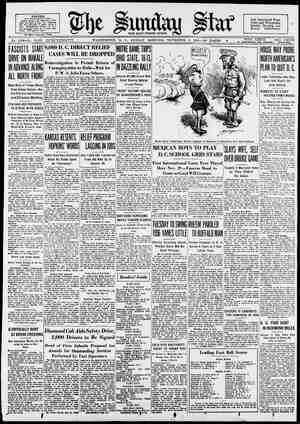Evening Star Newspaper, November 3, 1935, Page 7
You have reached the hourly page view limit. Unlock higher limit to our entire archive!
Subscribers enjoy higher page view limit, downloads, and exclusive features.
THE SUNDAY STAR, WASHINGTON, D. €., NOVEMBER 3, 1935—PART ONE. A STAE]MENT GENERAL MOTORS ENERAL MOTORS is presenting its 1936 offerings. The new cars are now on display by General Motors dealers everywhere. As you view the new models, you will see that progress by evolution has been continued. Nothing especially revolutionary or radical is being offered —our effort has been toward more safety, improved mechanisms, greater eye appeal—all with increased economy of operation and maintenance. These advances are the result of another year’s work by the General Motors engineering staffs. I believe you will like our cars for 1936. This year the time of announcing new models has been advanced in the hope that there will result more uniform retail sales. Such sales are highly seasonal. For instance, normally 12% of the cars are retailed during the month of April, as against 3% during the month of December. Production, therefore, is necessarily irregular. The annual income of the worker is adversely affected by this irregu- larity —-important, not only to the worker, but to the national economy as well. And this affects everybody. Any improvement will affect favorably the workers of many other industries. This is progress. General Motors recognizes its responsibility in this connection. It not only heartily supports the program, but in addition has set aside $60,000,000 as a stabilization fund. The objective is further to equalize employment through the accumulation of inventory by maintaining the manufacture of component parts during the winter when industrial employment is sub- normal and outside employment largely eliminated. General Motors asks your support toward this most worthy objective. In fact, the extent to which that objective is attained, depends upon your cooperation. So if you are thinking of a new car for 1936—buy now. There is no adequate reason why that car should not be purchased now. It is the same car, now or later. There is another problem of public importance in which General Motors récog- nizes a primary as well as a secondary responsibility—SAFETY. This problem involves not only the car, but the highway; and still more importantly, the driver and the pedestrian. Let us first consider the car—a primary responsibility. Safety involves construction.as well as maintenance. The “turret top” will be a part of all General Motors cars in 1936. This consists of a solid steel structure, with the supporting members in- tegral with the top and with the main structure of the body itself. Adequate strength is provided to insure safety even in the event of unusual accidents. This has been amply demonstrated by experience. “Knee-action,” or independent springing,- while looked upon only as providing a ““better ride” is in reality also an added safety device. Each wheel absorbs its own shocks—important in case of accidents or bursting of a tire. And Fisher no-draft ventilation likewise provides not only comfort, but safety as well. Many consider that safety and power are antagonistic. This is not necessarily so. Ample power, intelligently used, may well promote safety. Far less power, unintelligently used, may be hazardous. The motor car of today, notwithstanding the fact that power has been notably increased, can be controlled more effectively than the car of yes- terday. Here arises the importance of roadability, as well as of adequate and reliable braking. To the particular safety features mentioned might be added, if we look backward a moment, the electric starter, four-wheel brakes and similar advancements which General Motors first adopted as a quantity producer. Thus we see demonstrated that in General Motors engineering down through the years prime consideration has been given to safety. And others have made important contributions as well. j The motor car itself, however, is only a part of our problem. Much prog- ress has been made in advancing the safety of the highway construction-wise, in line with continually increasing traffic congestion. Acknowledgment is due those also who have contributed in the way of enforcement and better traffic planning. But, still more adequate highways are essential if we are to utilize to the utmost this young and virile instrument of trans- portation, the modern car. * Now, as to the driver and the pedestrian. General Motors believes this to be a problem not only of education but of continuous education. In that belief it pledges cooperation with all agencies whose duties or energies are directed toward highway safety. It proposes to make a tan- gible contribution by organizing, in a definite and aggressive way, to instill “Safety First” into the minds of those who purchase its products; to cooperate with all enforcement authorities, with respect to the problems of traffic control; to cooperate in devising ways and means of insuring safety maintenance; to promote new and better plans of regulation; to impress the importance of the problem upon our youth, and to cooperate in other ways, directly or indirectly, that offer promise of reducing the increasing highway toll that is being levied upon the community. General Motors is grateful for the endorsement of its 1935 products, which has made possible a world production of more than 1,500,000 vehicles during the year. The contribution thus made in an important aggregate of employment has accelerated the normal processes of indus- trial recovery.We shall strive to make a still more important contribution in the year ahead. . 4 - PRESIDENT
